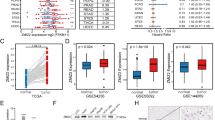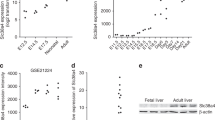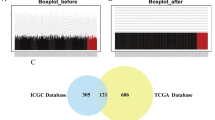Abstract
Loss of apico-basal polarity often results in a malignant phenotype in epithelial tissues. Aberrant expression of polarity mediator proteins is closely associated with this process. LRRC1/LANO, a putative cell polarity regulator, was previously screened from our gene expression profiling in which its expression was significantly upregulated in hepatocellular carcinoma (HCC). In the present study, we provide evidences that LRRC1 plays a potential oncogenic function in HCC. Consistent with the microarray data, quantitative real-time PCR results showed LRRC1 was aberrantly upregulated in 37/56 (66.1 %, more than twofolds) of HCC specimens compared with adjacent non-cancerous livers. Furthermore, the cellular expression of LRRC1 in all HCC cell lines examined exhibited much higher level than that in normal adult liver tissue. Functional analyses revealed that overexpression of LRRC1 promoted, while knockdown of LRRC1 by RNA interference inhibited the growth and colony formation of HCC cells. Importantly, enhanced expression of LRRC1 conferred NIH3T3 cells the ability of cell transformation. In a xenograft tumor model, we found LRRC1 overexpression increased the tumorigenicity of HCC cells. Thus, our collective findings suggest that LRRC1 contributes to HCC development, and may be a potential target for therapeutic intervention in this disease.





Similar content being viewed by others
References
Llovet JM, Burroughs A, Bruix J (2003) Hepatocellular carcinoma. Lancet 362(9399):1907–1917
Thorgeirsson SS, Grisham JW (2002) Molecular pathogenesis of human hepatocellular carcinoma. Nat Genet 31(4):339–346
Assemat E, Bazellieres E, Pallesi-Pocachard E, Le Bivic A, Massey-Harroche D (2008) Polarity complex proteins. Biochim Biophys Acta 1778(3):614–630
Humbert PO, Grzeschik NA, Brumby AM, Galea R, Elsum I, Richardson HE (2008) Control of tumourigenesis by the Scribble/Dlg/Lgl polarity module. Oncogene 27(55):6888–6907
Laprise P (2011) Emerging role for epithelial polarity proteins of the Crumbs family as potential tumor suppressors. J Biomed Biotechnol 2011:868217
Aranda V, Nolan ME, Muthuswamy SK (2008) Par complex in cancer: a regulator of normal cell polarity joins the dark side. Oncogene 27(55):6878–6887
Gardiol D, Zacchi A, Petrera F, Stanta G, Banks L (2006) Human discs large and scrib are localized at the same regions in colon mucosa and changes in their expression patterns are correlated with loss of tissue architecture during malignant progression. Int J Cancer 119(6):1285–1290
Navarro C, Nola S, Audebert S, Santoni MJ, Arsanto JP, Ginestier C, Marchetto S, Jacquemier J, Isnardon D, Le Bivic A, Birnbaum D, Borg JP (2005) Junctional recruitment of mammalian Scribble relies on E-cadherin engagement. Oncogene 24(27):4330–4339
Pearson HB, Perez-Mancera PA, Dow LE, Ryan A, Tennstedt P, Bogani D, Elsum I, Greenfield A, Tuveson DA, Simon R, Humbert PO (2011) SCRIB expression is deregulated in human prostate cancer, and its deficiency in mice promotes prostate neoplasia. J Clin Invest 121(11):4257–4267
Vaira V, Faversani A, Dohi T, Maggioni M, Nosotti M, Tosi D, Altieri DC, Bosari S (2011) Aberrant overexpression of the cell polarity module scribble in human cancer. Am J Pathol 178(6):2478–2483
Kamei Y, Kito K, Takeuchi T, Imai Y, Murase R, Ueda N, Kobayashi N, Abe Y (2007) Human scribble accumulates in colorectal neoplasia in association with an altered distribution of beta-catenin. Hum Pathol 38(8):1273–1281
Woo HG, Park ES, Lee JS, Lee YH, Ishikawa T, Kim YJ, Thorgeirsson SS (2009) Identification of potential driver genes in human liver carcinoma by genomewide screening. Cancer Res 69(9):4059–4066
Anastas JN, Biechele TL, Robitaille M, Muster J, Allison KH, Angers S, Moon RT (2011) A protein complex of SCRIB, NOS1AP and VANGL1 regulates cell polarity and migration, and is associated with breast cancer progression. Oncogene 31(32):3696–3708
Santoni MJ, Pontarotti P, Birnbaum D, Borg JP (2002) The LAP family: a phylogenetic point of view. Trends Genet 18(10):494–497
Bryant PJ, Huwe A (2000) LAP proteins: what’s up with epithelia? Nat Cell Biol 2(8):E141–E143
Wang L, Xu J, Wu Q, Dai J, Ye X, Zeng L, Ji C, Gu S, Zhao RC, Xie Y, Mao Y (2003) Cloning and characterization of a novel splice variant of the brain-specific protein densin-180. Int J Mol Med 11(2):257–260
Borg JP, Marchetto S, Le Bivic A, Ollendorff V, Jaulin-Bastard F, Saito H, Fournier E, Adelaide J, Margolis B, Birnbaum D (2000) ERBIN: a basolateral PDZ protein that interacts with the mammalian ERBB2/HER2 receptor. Nat Cell Biol 2(7):407–414
Huang YZ, Wang Q, Xiong WC, Mei L (2001) Erbin is a protein concentrated at postsynaptic membranes that interacts with PSD-95. J Biol Chem 276(22):19318–19326
Saito H, Santoni MJ, Arsanto JP, Jaulin-Bastard F, Le Bivic A, Marchetto S, Audebert S, Isnardon D, Adelaide J, Birnbaum D, Borg JP (2001) Lano, a novel LAP protein directly connected to MAGUK proteins in epithelial cells. J Biol Chem 276(34):32051–32055
Izawa I, Nishizawa M, Tomono Y, Ohtakara K, Takahashi T, Inagaki M (2002) ERBIN associates with p0071, an armadillo protein, at cell–cell junctions of epithelial cells. Genes Cells 7(5):475–485
Caruana G (2002) Genetic studies define MAGUK proteins as regulators of epithelial cell polarity. Int J Dev Biol 46(4):511–518
Martin JW, Yoshimoto M, Ludkovski O, Thorner PS, Zielenska M, Squire JA, Nuin PA (2010) Analysis of segmental duplications, mouse genome synteny and recurrent cancer-associated amplicons in human chromosome 6p21-p12. Cytogenet Genome Res 128(4):199–213
Chochi Y, Kawauchi S, Nakao M, Furuya T, Hashimoto K, Oga A, Oka M, Sasaki K (2009) A copy number gain of the 6p arm is linked with advanced hepatocellular carcinoma: an array-based comparative genomic hybridization study. J Pathol 217(5):677–684
Jia D, Wei L, Guo W, Zha R, Bao M, Chen Z, Zhao Y, Ge C, Zhao F, Chen T, Yao M, Li J, Wang H, Gu J, He X (2011) Genome-wide copy number analyses identified novel cancer genes in hepatocellular carcinoma. Hepatology 54(4):1227–1236
Zhang Y, Yeh S, Appleton BA, Held HA, Kausalya PJ, Phua DC, Wong WL, Lasky LA, Wiesmann C, Hunziker W, Sidhu SS (2006) Convergent and divergent ligand specificity among PDZ domains of the LAP and zonula occludens (ZO) families. J Biol Chem 281(31):22299–22311
Songyang Z, Fanning AS, Fu C, Xu J, Marfatia SM, Chishti AH, Crompton A, Chan AC, Anderson JM, Cantley LC (1997) Recognition of unique carboxyl-terminal motifs by distinct PDZ domains. Science 275(5296):73–77
Krepischi-Santos AC, Rajan D, Temple IK, Shrubb V, Crolla JA, Huang S, Beal S, Otto PA, Carter NP, Vianna-Morgante AM, Rosenberg C (2009) Constitutional haploinsufficiency of tumor suppressor genes in mentally retarded patients with microdeletions in 17p13.1. Cytogenet Genome Res 125(1):1–7
Dardousis K, Voolstra C, Roengvoraphoj M, Sekandarzad A, Mesghenna S, Winkler J, Ko Y, Hescheler J, Sachinidis A (2007) Identification of differentially expressed genes involved in the formation of multicellular tumor spheroids by HT-29 colon carcinoma cells. Mol Ther 15(1):94–102
Frese KK, Latorre IJ, Chung SH, Caruana G, Bernstein A, Jones SN, Donehower LA, Justice MJ, Garner CC, Javier RT (2006) Oncogenic function for the Dlg1 mammalian homolog of the Drosophila discs-large tumor suppressor. EMBO J 25(6):1406–1417
Acknowledgments
This work was supported by grants from the Chinese National Key Projects for Infectious Disease (2012ZX10002012-008) and Chinese National Key Program on Basic Research (973 Program) (2010CB529204 and 2010CB529206).
Conflict of interest
The authors have declared that no conflict of interest exists.
Author information
Authors and Affiliations
Corresponding author
Rights and permissions
About this article
Cite this article
Li, Y., Zhou, B., Dai, J. et al. Aberrant upregulation of LRRC1 contributes to human hepatocellular carcinoma. Mol Biol Rep 40, 4543–4551 (2013). https://doi.org/10.1007/s11033-013-2549-8
Received:
Accepted:
Published:
Issue Date:
DOI: https://doi.org/10.1007/s11033-013-2549-8




